
|   |

|   |
Unity in diversity at Saila Sudha’s Nrityasangama - Lalitha Venkat, Chennai e-mail: lalvenkat@yahoo.com Photos courtesy: Saila Sudha September 29, 2012 Saila Sudha presented the fifth edition of its annual festival Nrityasangama, a confluence of dance, on September 22 and 23 at Bharatiya Vidya Bhavan, Chennai. It was dedicated to the memory of Sailaja’s Guru Vempati Chinna Satyam. Featuring the diverse dance forms of Kathak, Yakshagana and Manipuri on day one, followed by Mohiniattam, Kuchipudi and Bharatanatyam on day two by top ranking artistes, it was indeed a feast for dance lovers and the jam packed auditorium attested to that. 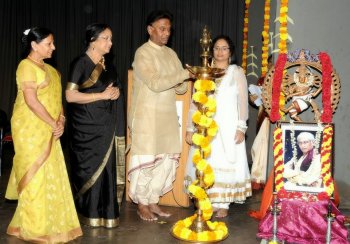
Inauguration
The festival was inaugurated by Padma Subrahmanyam, who commended Sailaja for presenting artistes of other art forms at her festival. Saila Sudha’s contribution of Rs.50,000 towards Padma Subrahmanyam’s Bharata Ilango Foundation lent a feel good cheer to the event. The chief guests were Kuchipudi duo Radha and Raja Reddy. Referring to Sailaja as Bharata putri, Raja Reddy commended her for hosting a festival of diverse art forms to show unity in diversity. 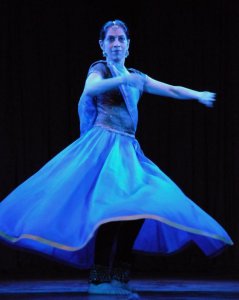 Aditi Mangaldas The program started with a Kathak recital by Aditi Mangaldas and two male dancers of Drishtikon Dance Foundation, Delhi. She started with ‘Varsha’ (monsoon), an extract from ‘Footprints on water.’ The roll of thunder, the lightning across the sky that changes color, the croaking frogs and dancing peacocks, the wet bird and the pitter patter of raindrops were evocatively depicted by Aditi in this solo with music composition by Shubha Mudgal. ‘Gurave Namah’ paying homage to a Guru, who like the almighty is present in the five elements, was a vibrant duet featuring Dheerendra Tiwari and Piyush Chauhan, with music by Samiullah Khan. Choreographed by Aditi, Kathak was interspersed judiciously with martial art movements. In both these numbers, one could savour the slow and fast movements with the audience applauding every now and then, especially for the chakkars! The final item was ‘The River,’ an extract from ‘Now Is’ by all dancers with suitable change in costume. In contemporary style based on Kathak, it featured some wonderful percussion as prelude to vocals by Shubha Mudgal and Bombay Jayashri. It goes to Aditi’s credit that she apologised to the audience for the rather loud volume of the music, since she was unable to convey her request to the tech support. Not that the audience had noticed, used as they are to loud volumes in general! 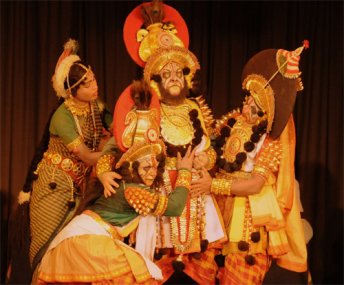 Vali Moksha Keremane Shivananda Hegde and members of his Shri Idagunji Mahaganapati Yakshagana Mandali from Karnataka, clad in colorful, gorgeous costumes, head dress and elaborate makeup mesmerized the audience with a gripping depiction of Vali Moksha. The entry of Rama and Lakshmana, the abduction of Sita, search for Sita, entry of Hanuman and the monkeys (a big hit!), entry of Sugriva, Vali-Sugriva fight where the latter is defeated, their fight again when Rama shoots an arrow at Vali, moksha of Vali were packed beautifully in a one hour presentation high on drama with commanding vocals (Anant Hegde) and percussion that lent such drama to every scene. Though lyrics and spoken dialogue was in Kannada language, the evergreen Ramayana is so ingrained in the Indian psyche that language was no barrier and had the rasikas eagerly relishing every scene. The majestic Rama was played by Shivananda Hegde. The body language of Sugriva was simple and effective especially when he asks Rama why he had not killed Vali. There is a touch of humour when Rama tells Sugriva that he could not since both looked alike from a distance and Sugriva then wears a garland as identification! Sugriva clearly had a stellar role. The dying scene of Vali was so poignant that the audience watched in pin drop silence, breaking into thunderous applause as the scene ended. 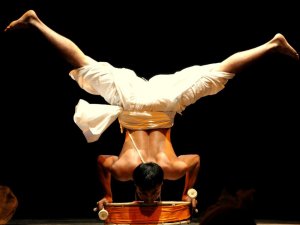 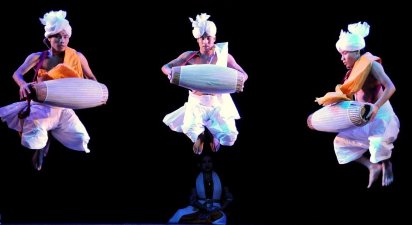 Priti Patel and group 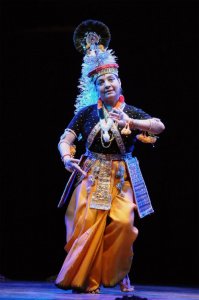 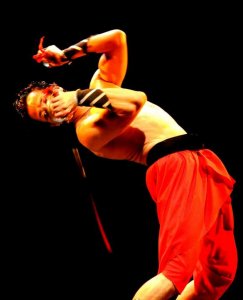 The stunning display of pung cholom and dhol cholom (dhol is a large drum), combining dance, drumming and acrobatics in skilful coordination, thrilled the rasikas. Sun is also Vishnu. The indestructible atma is Madhusudan himself. Krishna plays the cosmic raas lila with Radha and the gopis to accompaniment of sankirtan music. Priti Patel as Krishna, Radha and the gopis in the typical Manipuri cylindrical costume in green and red respectively dazzled in the final segment. The presentation had English voice over and the narrative progressed smoothly without interruption, featuring all elements of a Manipuri dance recital. One did not realize that the orchestra had been seated in the left wing! Suraj Kumar on vocal, Gagan Singh on pung and Ratan Singh on flute enhanced the presentation with their strong musical support, as did the aesthetic lighting. It was a pity the inexperienced compere used high sounding words in the wrong contexts and also insisted on using the title prefixes of Padma and Kalaimamani every single time an artiste’s name was mentioned… Since all performers of the fest as well as special invitees were awardees, it got to such a point that one was ready to scream in frustration! 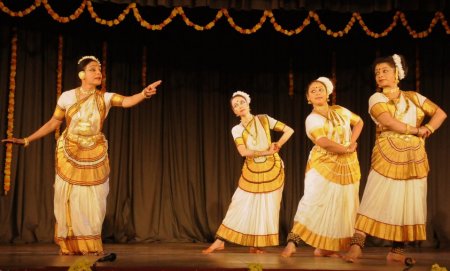 Bharati Sivaji and group The second evening started with a serene Mohiniattam presentation by Bharati Sivaji and her group from Delhi. Ganapathy stuti to sopanam music wove images of this son of Shiva and Shakti, his flapping ears, waving trunk and so on. In Devi stuti, the goddess was evoked in Aarabhi ragam set to adi talam. “For many centuries, Kerala has the tradition of rendering ashtapadis in the sanctum sanctorum, sung in distinct sopanam style (sopanam meaning ‘steps that lead to the sanctum),” said Bharati. It was about Krishna’s dalliance with the gopis as Radha looks on, in ragam Pantuvarali followed by Mohanam. It was interestingly choreographed as a group item for the four dancers. Bharati Sivaji was a charming, doting mother in the famous Thalattu (lullaby) ‘Omanathinkal” by Irayaman Thampi, said to have been written for Swati Thirunal when he was a baby. The concluding group item was the popular ‘Pandattam’ composed by poet Vallathol Narayanan in ragam Kambodhi. The poet compares the ball going up and down to life’s ups and downs. Not only did the imaginary ball get tossed between the dancers, it was also thrown into the audience and thrown back to the dancers! The beautiful costumes and the swaying movements were soothing to the eye. Vinaya Manoj, Deepa Nair and Olga Stolirova did their guru proud. 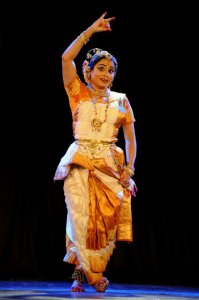 Sailaja The hall was already overflowing with enthusiastic rasikas trying to find seats as Sailaja and dancers of Saila Sudha presented a lively Kuchipudi recital featuring choreography of Sailaja’s guru Vempati Chinna Satyam. Watching a Kuchipudi program in Bharatanatyam dominated Chennai is as rare as watching maybe Chhau! “Jagada ananda karaka” was an energetic start. The Balagopala Tarangam by Narayana Teertha highlighting the pranks of the child Krishna ends with dance on the brass plate. This solo by Sailaja was a highlight of the presentation and was enthusiastically applauded by the rasikas. Sailaja first simulated dance on the brass plate before following it up with the actual dance on the brass plate, making us wonder if this was her innovation or if Vempati master had choreographed it that way. She confirmed later that all items she presented were her guru’s visionary choreography all those years back. Even as Sailaja was dancing this central piece of a Kuchipudi repertoire, some weird things were going on above her. Two horizontal panels above spanning the length of the stage, one strung with flowers, kept moving up and down, left and right! Reminded me of last year’s festival by Sailaja, when Anita Ratnam was presenting an excerpt from ‘Avani’ in the morning, a rope suddenly dropped down on the left front of the stage from above and about 10 minutes later, it disappeared as suddenly as it had dropped down! 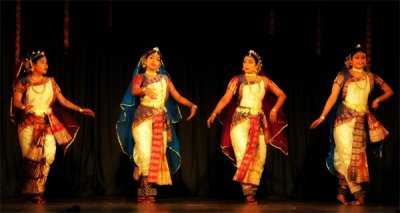 Apsarasa In ‘Apsarasa,’ an excerpt from a dance drama, the four divine apsaras Rambha, Menaka, Urvashi and Tilottama dance to impress in Lord Indra’s court. A lively piece with lot of pure dance, the footwork of the dancers was well coordinated and they had the opportunity to display their prowess in solo, duo and group combinations. The Kuchipudi presentation concluded with Ananda Thandavam. Since the group alternated with solo by Sailaja, with neat entries and exits, the stage did not look crowded. The well trained dancers were Aarti Vasudevan, Janani Hari, Janani James, Janani Balaji, Sreshta S Kumar, and Kaichi Lo from Taiwan. The supportive orchestra featured Girija Ramaswamy on vocal, Sailaja Sivakumar on nattuvangam, Srilakshmi on violin, Guru Bharawaj on mridangam and PV Ramana on flute. An emotional Sailaja recalled her 16 year association as a student of Guru Vempati Chinna Satyam. 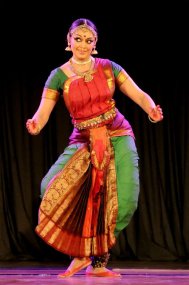 Shobana Chandrakumar The number of standees had now swelled to more than a hundred to see the grand finale. The Bharatanatyam presentation by Shobana Chandrakumar and students of Kalarpana was – different. To a loud recording of AR Rahman’s ‘Vande Mataram,’ the dancers shrouded in smoke, went through their moves. The choreography included a shooting scene with rifles, one falls down dead and how she managed to remain so stiff when carried by other dancers was remarkable! The item ended with a dancer rushing in with an Indian flag and the audience whistled and cheered – maybe a combination of patriotic fervor and admiration for the dance. ‘Thevaram’ was a solo by Shobana and her very entry in green and red costume had the rasikas in thrills. The music sounded loud in places. The sringara varnam was “Vanajakshi” and half way through her performance, with a smile on her face and gesture indicating a camera, Shobana indicated to an audience member not to take pics! This was followed by students of Kalarpana performing Bharatanatyam to Bach! 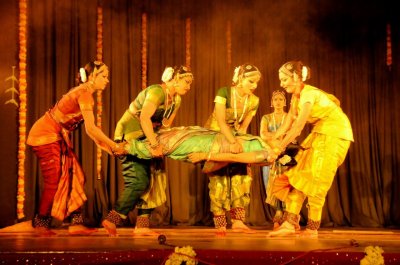 Shobana’s group Shobana called the next group item a ‘Collage of Ashtapadis’ where a story is narrated. Krishna promises to meet Radha but he is seen making merry with the gopis. Radha tells her sakhi that she’d rather die than have Krishna avoid her. Sakhi tells Krishna that even applying sandal paste on her body made Radha suffer. Krishna goes to Radha to pacify her, but she asks him to go away. Of course, in the end, they unite. Lalita lavanga, Nindati chandanam, Yahi Madhava and Priye Charusheele were sung without any soul by the vocalist. In the last scene, there suddenly appeared a bush like thing and 2 dancers as peacocks (wearing small fans of real peacock feathers) as the divine pair reunite! The finale was a thillana, a Swati Thirunal composition in Ananda Bhairavi ragam that Shobana described as a “fusion of Bharatanatyam and Mohiniattam” and had 4 dancers representing each dance form. Shobana’s dancers did their part well, including the rather filmy movements that have crept into the choreography. Needless to say, the enthusiastic audience clapped at the beginning, in the middle and at the end of every item, and stayed till the very end. Sailaja’s aim is to familiarize the Chennai audience with different art forms and also create an active interaction with the artiste community through lec-dems and seminars apart from performances. True to her ideals, the earlier 4 editions of the annual festival had included a morning seminar, but it was dispensed with this year as Sailaja realized that despite inviting seasoned veterans to share their knowledge, there was poor response from dance students in Chennai. So it was a sensible move by Sailaja this year to stick to presenting top performers in the evening and the overwhelming response has been truly worth all her hard work. Happy with the unprecedented success of this year’s fest, Sailaja says, “The 5th edition of Nrityasangama this year has been closer to my heart than the prior 4 editions and there are more than one reason for the same. Being a performer and a teacher, to conduct a festival on national level has been a huge responsibility that I have shouldered happily and this year I wanted to make it special being the milestone year (Saila Sudha celebrates 25 years of its existence next year). My vision for Nrityasangama has always been multi-dimensional, one being to bring various dance forms of our country to the layman at no cost and second being the performers should be treated and rewarded as I would expect from any other organizers. As a fitting tribute, this festival was dedicated in homage to the legendary Kuchipudi guru Dr. Vempati Chinna Satyam, which brought to life some of the selected favorite items choreographed by the maestro. This year, due to an amalgamation of great artistes and proper marketing strategy, we saw the venue being overwhelmingly crowded with dance enthusiasts who did not mind waiting to try their luck to get in. This brings in an additional responsibility to make the coming year even better and to make sure every single person attending the event should be comfortably seated. Last but not the least, there are a few people who are responsible for making my vision for Nrityasangama come true year after year. In this world where every donor or sponsor is fighting for visibility, Saila Sudha has been blessed to have true art lovers who have been more than generous to make this event achieve its goal. They shy away from all visibility but I would like to thank them because without them these events are not possible.” Lalitha Venkat is the content editor of narthaki.com |